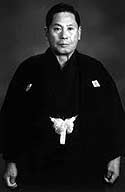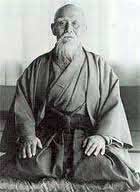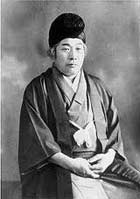Martial Arts: Aikido
Aikido: Dichotomy between the Martial and Spiritual
By Alister Gillies
“Those who are at war with others are not at peace with themselves.”
-
William Hazlitt
 |
Sokaku Takeda |
Aikido is a relatively modern martial art that tacitly acknowledges links with its Koryu arts (Japanese classical warrior arts and their derivatives) of the past past. It stems directly from the Daito-ryu Aikijujutsu of Sokaku Takeda (1859-1943), who departed from the Aizu clan tradition and began to teach selected individuals outside the clan system around the turn of the nineteenth century.
Takeda deliberately targeted dignitaries and public officials of high rank and influence as potential students, and was not averse to rejecting people of dubious character. He had a strong sense of social responsibility, and a horror of his teaching falling into the wrong hands. During his lifetime he is said to have had some thirty six thousand students. His best known student was Morihei Ueshiba, the founder of Aikido.
Takeda himself had been taught martial skills by many different teachers, and had reformulated the techniques of Daito-ryu that had originally been taught to him by his father and the priest Chikanori Hoshina. The origins of Daito-ryu are far from clear, but it is believed that the art has the same root as Sumo in an ancient art called Tegoi.
The art of Tegoi, it is claimed, was passed down from the descendants of the Emperor Seiwa (858-876), through the Seiwa-Genji family line. Shinra Saburo Minamoto no (Genji) Yoshimitsu (1045–1127) was instrumental in much of its later modifications, adapting the art as circumstances and knowledge permitted.
Yoshimitsu is said to be responsible for the formal codifying of the ‘secret’ Aiki techniques that make both Daito-ryu and Aikido so distinctive. It is also known that Yoshimitsu studied Chinese military tactics, and it is at least likely that there are other Chinese influences in the art’s formation.
 |
Tokimuni Takeda , who continued teaching his father's daito-ryu tradtion. |
In actual fact, very little is known about the obscure art of Tegoi, and only oblique references can be found in the Shinto text Kojiki (Records of Ancient Matters). According to Tokimune Takeda (1916-1993), the late Headmaster of Daito-ryu (son of Sokaku), it was Sumo and its core “Aiki In-Yo (yin-yang) method” that constituted the basic techniques of Daito-ryu Aiki Jujutsu.
Masanori Hoshina (1611-1673) was an important figure in the subsequent development of Daito-ryu in the seventeenth century, revising the art into a self-defence art called Oshikiuchi (lit., court self-defence art). He also studied the secret sword arts of Onoha Itto Ryu. The transmission of these two arts, Onoha Itto Ryu and Oshikiuchi, became a mandatory requirement for the retainers of succeeding Aizu Lords.
Oshikiuchi was taught in the main to nobility – both male and female – and contained large movements with wide stances (for use when wearing armour), and smaller range movements for instances when movement was cramped (in residential areas, and during formal occasions). As the term ‘uchi’ (inside) would suggest, it was an art that was confined to the inner circle of the court. At a time of conflict, when all outer defences had been overcome, the last battle would be staged in the restricted confines of the court where large movements were impracticable.
 |
Morihei Ueshiba |
When Morihei Ueshiba reworked Takeda’s basic techniques in his formulation of Aikido, he was doing no less than what Yoshimitsu, Hoshina and Takeda had done before him. Aiki is a mind-body quality implicit in the execution of technique, rather than a series of prescribed physical movements. It permits infinite variety and interpretation.
Examples of this ‘minimalist’ Aiki movement can be seen in the current techniques of Daito-ryu and Aikido. It is exemplified in the present-day students of Yukiyoshi Sagawa (1902-1998) and Kodo Horikawa (1894-1980), former students of Sokaku Takeda.
Both Horikawa and Sagawa contributed their own unique expression to the arts taught by Takeda, and their successors continue to do the same. A teaching license issued by Kodo Horikawa, explicitly granted one of his students, Seigo Okamoto, the right to create his own techniques. Aiki is an essentially creative principle that arises naturally from the mastery of basic technique.
Sokaku Takeda was regarded as an unrivalled master of his day, and without his influence and mastery neither Daito-ryu Aiki Jujutsu nor Aikido would be what they are today. In one sense, he was a relic of an age past, inculcating conservative values and principles that looked backwards in time. In another important sense, he was a guardian of knowledge and skills that were in danger of being lost as Japan made the transition from its feudal past to the modern age.
What he taught contained the seeds of an ethical and moral system that embodied Confucian notions of self-control, social harmony, etiquette, respect for elders, and obedience to the teacher – ideals that are still very much alive in modern day Japan. While there was no doubt an element of personal development in the study of Daito-ryu Aikijujutsu, it remained understated under Takeda’s direction.
The importance of the individual in Japan has always been subordinate to that of the group or society. This is reflected in the primacy of values that reinforce conformity within the framework of a vertically structured, hierarchical system. ‘Wa’, or social harmony, is everything in Japan.
 |
Onisaburo Deguchi |
Morihei Ueshiba’s teaching differed from Takeda’s in the unprecedented emphasis that he placed on Aikido as a vehicle for personal transformation. In this respect, Ueshiba was influenced as much by his connection with the charismatic Onisaburo Deguchi (1871-1948) and the Omoto Kyo religion, as by his own spiritual insights.
While Takeda was more concerned with passing on effective techniques for actual combat, for the restoration and preservation of social harmony, Ueshiba’s focus was explicitly on harmony in the heart of the individual. For Ueshiba, inner harmony underpinned social concord.
The tensions between Takeda and Ueshiba were not only those of a protégé and mentor, or an individualist versus a collectivist orientation, they were the result of a fundamental difference in their understanding of the nature of Budo itself.
Ueshiba’s approach was radically different: Aikido was a Budo of love and the ‘divine techniques’ of the art were ‘misogi’, a way of spiritual purification. His Budo was for the modern age; the age of steel and blood had gone.
The founder of Aikido dedicated his entire life to finding a way of bridging heaven and earth, using Budo as a vehicle. His martial studies, intuition, religious experience and knowledge of the Chinese and Japanese classics all informed him that such unification was possible.
But when Morihei Ueshiba split from Sokaku Takeda, he also carried with him the seeds of a martial/spiritual dichotomy that took him many years to resolve. That he was successful in unifying these opposing elements in his own life and practice singles him out as a unique individual in the history of the martial arts.
When he died, he left behind the legacy of a path that he had pioneered personally, but this did not necessarily make it any easier for those who came after. A teacher may point the way, but only the student can travel its length.
To this day, there is still some tension between the martial and spiritual aspects of Aikido, with some styles claiming that they are more ‘realistic’ (martial), and others that they are more ‘spiritual’.
Morihei Ueshiba may have left behind a system of teaching and practice that contains at its core the opportunity to resolve the apparently irreconcilable, but it is not a method that guarantees it. Each student, regardless of style or affiliation, must find their own way to the heart of what Aikido offers.
Unlike many other modern martial arts in Japan, Aikido is not sports oriented. Although there is a style of Aikido that was developed by one of the founder’s early students (Tomiki), that was specifically adapted with competition in mind, it has not proved as popular as might have been expected. Aikido remains non-competitive in its essential nature and current practice.
In most respects, Aikido is very typically Japanese. In this sense, it very closely resembles what is collectively referred to as Haragei in Japan, the cultivation and development of Hara (the seat of spiritual power in the abdomen) in a chosen activity. It is in this regard that Aikido, Zen and many other arts can be said to converge, or at the very least, be seen as having a common root or cultural flavour.
If Aikido is construed as Haragei (lit., “belly-art,” refers to a highly-developed intuition), then it is possible to locate it firmly within a broad cultural tradition that encapsulates both modern martial arts, Koryu arts, Zen training and many other art forms that have no direct martial application. In Japan, such arts have traditionally been the mainstay for the transmission of social behaviour and morals designed to support individual development and social cohesion.
The martial arts of Japan are not simply techniques for life and death situations of conflict; they are also a way of mind, body and spirit cultivation for the whole person and society at large. They exemplify the concrete expression of philosophical and moral values drawn from Confucianism, Taoism, Buddhism and Shinto.
The test of whether something is Haragei or not is determined, amongst other things, by its longevity – does it stand the test of time? Does it function as a way of enriching one’s life in the present; is it meaningful and rewarding in itself; and does it extend beyond itself and filter into one’s daily life and society at large?
In his book Hara: The Vital Centre of Man, philosopher and Zen practitioner Karlfried Graf Dürckheim writes that when Haragei is cultivated:
An all-around transformation of all one’s faculties takes place, unhindered by the limitations of the five senses and the intellect. One perceives reality more sensitively, is able to take in perceptions in a different way, assimilates them and therefore reacts differently and, finally radiates something different…The three fundamental reactions to life and the world—perception, assimilation, and response—change in the direction of an expansion, deepening, and intensifying of the whole personality.
Dürckheim’s book describes Haragei as a quality of presence in which the sensibility of the belly is fully integrated into any activity, from the subtle ritual of the traditional tea ceremony to the focused intent of an archer drawing their bow, or the graceful stroke of a calligrapher’s brush. It is present in Aikido when the art is cultivated to its optimum level.
Within this tradition of Haragei, the emphasis has always been on what D.T. Suzuki, the Zen Buddhist scholar, described as radical empiricism – finding out for one’s self. From this point of view, it is not surprising that the Founder of Aikido, Morihei Ueshiba (and other Japanese teachers since his time), did not explain what they were teaching beyond the necessary forms of kata (prescribed forms).
Some Japanese teachers even assert that they will take what they know with them when they die. This is incomprehensible to the average Westerner, and perhaps some modern-day Japanese, too. But it is perfectly in line with a mode of teaching in which the student bears most of the weight of the learning process. It can’t be any other way. Haragei is not something a teacher can give to a student.
If one accepts that Aikido has a history, which it undoubtedly has, then it is clear that Morihei Ueshiba underwent an apprenticeship, drawing his martial skills from a variety of sources and teachers within the world of classical Budo. From the view point of Haragei, the individual details or technical sources of his skills are not particularly relevant.
There are many Haragei arts in Japan, and although the external forms differ from art to art, there are ‘internal’ features that are common to all. Most Japanese understand this and refer to the martial arts using the generic description ‘belly arts’.
In Aikido, for example, many of the Founder’s students went on to develop their own style of Aikido that, while sharing the common name Aikido, became quite distinct from one another. But from the perspective of Haragei it all makes sense – it enfolds unity and diversity within its perspective without contradiction:
“Equality without discrimination is poor equality; discrimination without equality is poor discrimination” – Chinese mirror verse.
The path of Haragei, shared by Aikido and many other arts, is broad with a long tradition and history. It is contained in the Soto Zen tradition of Dogen that came from China and flowered in Japan. It is deeply interwoven into the fabric of the culture and psyche of the Japanese people.
‘One Point’, ‘Seika Tanden’ and ‘Centre’ are terms commonly found in Aikido, but these terms do not fully convey the significance of Hara. They are starting points at the beginning level from which the student can progress, as Dürckheim explains, to experience the “ground of being” and its connection to the “totality of being” in activities of everyday life.
The Founder of Aikido alludes to such an experience in his verse, framed in his own idiosyncratic style:
“Create each day anew by clothing yourself with heaven and earth, bathing yourself with wisdom and love, and placing yourself in the heart of Mother Nature.”
At the heart of Japanese Budo and Zen is the fundamental belief that the realisation of our ‘true nature’ is man’s natural heritage. Tomio Otani, one of the original pioneers of Japanese Budo in Britain, wrote in the early 1960s of the purpose of Budo:
“The highest purpose of Budo is to awaken mankind’s spirit to the direct realisation of our true nature.”
About The Author:
Alister's background is in project development. He is trained in counselling and personal development, although his academic background is in English literature. He has an MA Hons degree in English literature from the University of Glagow, and was the University's Alister Buchan Poetry Prize Winner in 1987.
He has worked in a number of different sectors, some of which include social housing, justice, addiction, community and teaching. He works with organisations, groups, and individuals helping them to negotiate and manage effective change. He helps people to come up with strategies to promote development.
He has been writing for many years, and is a published poet. He also writes short stories, blogs and occasional articles about Aikido philosophy and practice. He is a Fourth Dan Aikido teacher and runs a dojo in Bristol.
He is very interested in Japanese culture and has visited the country a few times, and shares their love of nature. One of his favourite pastimes is to go rambling with his wife in the UK countryside, especially the South West coastal area.
Alister comes from the Western Islands of Scotland, a beautiful and wild environment. He likes to travel, and frequently goes to Europe to attend Aikido Seminars.
His writing is a reflection of his interests, which include eastern and european philosophy and literature, travel, poetry, cooking, society and justice, spirituality, reading, and film and theatre - to mention only a few. |